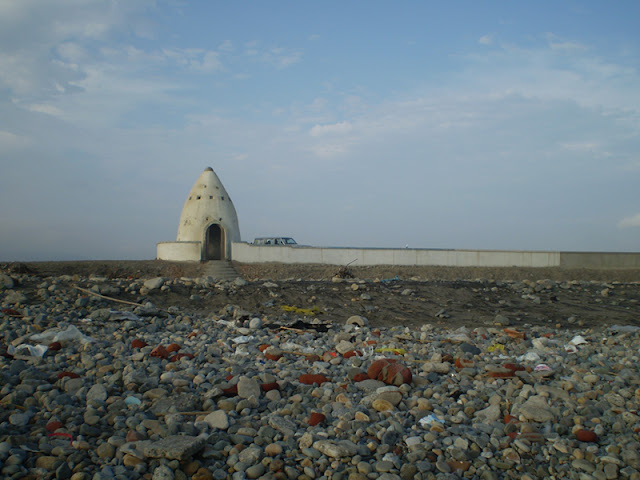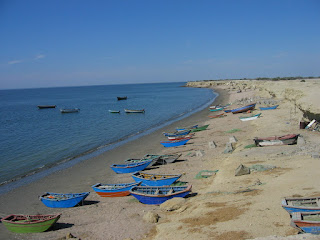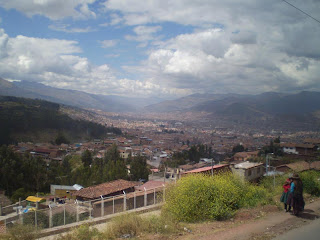May 25th,
2012 (Friday, Weekend)
Over the
weekend we stayed and chilled at the volunteer house, which happened to be
Michael's house, in the city of Trujillo.
There are 2 rooms with 6 bunk bed spaces. The house staff cooked great,
healthy meals for us.
While
most of Peru eat fried chicken (due to food safety reasons) and rice, with very
little veggies, one could order a 2L jar
of freshly squeezed juice almost wherever you go. (Of course since juice is
made with ice so that's not exactly "safe" either, but a lot more
delicious than salad!)
Back on
topic, lunch is the main meal in Peru and the volunteer house staff prepares
for us great big lunches on weekdays. Dinner consist of soup and bread. The
local spicy sauces are quite exotic and I've tasted a few different kinds.
Trujillo
itself is a sprawling and flat city, with colonial atmosphere and very few
high-rise buildings. The climate is perpetually 20 degrees and never rains.
Crime is actually something one have to watch out for in this city and
foreigners should go out in groups. There a zoo different of taxi and bus
services in Trujillo, the yellow taxis are not safe, but "New Taxi"
is reputable (in fact, the drivers pay a premium and the company punish drivers
for breaching their strict regulation, to maintain their standard of conduct).
Michael's house in Trujillo is located in a safe and relatively uppity
neighbourhood, with supermarkets and malls about 20min walk away.
On the
weekend the volunteers went to the supermarket to get food and my friend, who
really enjoys cooking, organized a volunteer cook-together and made a meal. But
other than this, we volunteers were, unfortunately, rather lazy and
couch-potatoed most of the weekend. Instead of watching TV, I doodled in my
sketchbook, and caught up on world news. But not being fluent in Spanish, I
didn’t want to go outside by myself.
Also
during the weekend Michael took us to see Buenos Aires. This used to be a
nice-ish beach until someone near the delta decided to change how the river
enters the sea, as part of a project. The result is that sand on the beach is
no longer replenished. Most of the beach is gone, in fact, 40m or so of sandy
beach was supposed to have disappeared over 4 or so years, replaced by a rocky
field filled with junk of the Pacific. We then went to see the meteorological
station that Michael built, also near the sea. It was a small egg-shaped
building was to house equipment for testing of WindAid's wind turbines. Due to
beach erosion ocean spray gets closer to the egg building and the salty mist
over time has eaten through even concrete - this is no place for electronics.
This
weekend another long term volunteer arrived to join us, coming from Scotland,
making it 5 volunteers altogether. Apparently for unknown reasons there has
been many Scottish volunteers before.




May 28th,
2012 (Monday)
First day
at the workshop!
The
workshop is about 20min away by car, and of course we had to stop on the way
there for the Inca Kola and cigarettes for our boss.
The
WindAid workshop is a warehouse space about 30x30m with sections near edge of
the room divided off for different tasks, and center of the building used for
general work and assembly. There's an electronics area, resin casting area,
welding area and painting area. There's various scrap metal and machines like
CNC mill and plasma cutter.
On the
first day we did not get to the workshop by 11am since Michael had to work on
some calculations for the plan to electrify the community of Playa Blanca. We
end up familiarizing ourselves with the workshop by taking turns learning to
weld, and coiling wires for the generator. We left the workshop at 2pm to go
home for lunch, and one of the volunteers asked Michel "are we going back
after lunch?" to which he replied, "no, normally this is it."
At first
I did not believe that I heard or understood it right, but as no one is driving
the truck after lunch the volunteers settled into their normal spots on the
couch and watched TV all afternoon… (*facepalm)
May 29th, 2012 (Tuesday)
This was the day we learned how to cast turbine blades. The blade is made of steel rod core, surrounded by a cast foam core. We had to carefully wrap the core foam in carbon fibre and then glass fibre. Then place the whole thing in a mould and clamp the mould shut, using 20 or more C-clamps.
The mould is unfortunately made of the same material as the final resin, so the mould must be generously waxed to prevent the blade from bonding with the mould. We hot-glued the mould and checked for air leakages, then hooked up the casting pipes and poured mixed resin into the mould.
The mould is hung like a slab of meat or wounded animal on a hook. It was truly a horror-story scene. Negative pressure draws resin into the mould and it is all left overnight to solidify.




May 30th,
2012 (Wednesday)
This day
we played soccer with taxi drivers in the mini-soccer field in the mall, in the
morning, before going to work. I chatted with Michael about his career and his
stories. Michael grew up in Indianapolis and worked on an Airforce base after
highschool. He did databases and websites for a few years after that, then
started an import business. Michael also had an interest and got training in
rally racing. After re-evaluating living in the States, he moved to Peru in
hopes of doing some societal good and the rest is history. (Sorry for
butchering this, Michael. As you can see, I'm a very dispassionate writer.)
May 31st,
2012 (Thursday)
This
day we left work early and Michael drove us to the temple of Sun and Moon.
These are built by the Moche people, and the names of the temple are invented
by archaeologists, rather than the original names. [http://en.wikipedia.org/wiki/Moche ]
These temples took
the form of raised hills (pyramid-like) with some structures on top, of course
there are no internal rooms inside the pyramid save for buried objects or older
versions.
The "Sun"
temple was the administrative region, it is not open to the public. The
"Moon" temple was used for religious purposes. Warriors fought to the
death and their blood was used to soak the ground. The losers may have been
skinned or ripped apart dead or alive. For all the graphic violence, this was a
religious ritual and the areas where all the violence takes place are not
accessible to the public. However, the "king" would have held the
head of the sacrifice for the crowd awaiting outside to see, so they would have
proof that the rituals are indeed done. The Moche worshipped Decapitator God,
and decorated the temple with various forms of his face. The outside is
decorated similarly, although tied slaves, dancing jesters and animals can also
be seen. The 1700 year old paint job is
colorful and vivid due to being buried in the ground.
All
corporations in Peru need to somehow satisfy a "public good"
requirement. Most do very little to get by. However, the Moche archaeological
park is looked after by the local beer company, who took excellent care of
administration due to the strategy of long term commitment.
We took
one of the microbuses back to Trujillo. It was a tight squeeze with 15+ people
in what I call a "hippy van" that must've originally had seats for no
more than 8.



June 1st,
2012 (Friday)
Judging
from the photos, we might have actually worked until dark (all 8 hours) this
day!

June 2nd,
2012 (Saturday)
This
afternoon we went to the beach town of Huanchaco, another nice beach/surfing
place. However this beach suffers the same beach erosion problems, although not
as crippling as Buenos Aires. I sketched and explored the area while other
volunteers played in the water and played beach ball. I found a nice stuffed
fish museum which also had model ships. Locals at the beach asked where I'm
from, and whether I have the world-famous Canadian product of "weed"
which I did not.
We
watched the beautiful sunset, had dinner, then martinis at a reputable
beachfront place. We left at about midnight and wandered back and forth along
the beach in hopes of catching one of the more reputable taxis. It was
high-tide and the waves washing over rocks made a demonic skull-cracking noise.
(We then debated passionately about the logic of that claim, with no one
actually having ever cracked a skull - I hope!)
Eventually
we caught a "New Taxi" heading back to Trujillo after 1am! Despite
notoriety of South American nightlife, the peaceful beach town does not stay up
late, and this must've been the last car to be out and about. The driver was as
happy to see us as we were him.



June 3rd,
2012 (Sunday)
Not much.
Couch potato-ing. Might have had soccer, my friend organized another
cook-together and watched movie after. We may have reviewed the Batman
franchise in preparation for Dark Knight Rises.
June 4th,
2012 (Week of)
Most of
this week Michael was not here. Mr. Able drove us to the work shop in his
yellow taxi! (The yellow taxis are the least reputable taxi line in Trujillo
and Michael warned us not to get in one on the risk of armed robbery).
This week
we worked mostly full 8 hour days, due to last week's boredom of
couch-potatoing. On Monday we cleaned up the whole workshop, whereas Michael
went to Playa Blanca again, trying to bring them a (better) working inverter.
On
subsequent days we helped with WindAid's experiment of a smaller, 2-bladed
turbine. This turbine would be produced more easily and in greater amounts. In
fact, the concept calls for a parent mould to produce copy moulds, which can be
given to local groups to cast their own turbine blades. However everything is
in experimental stage, and mould-making is hard due to the amount of resin and
fibres needed, which all must be laid out in neat layers. Due to this work and
our various long road-trips we could not finish one of the large turbines. (We
did wind the number of copper coils, and cast all 3 blades, so despite all the
procrastination it was still significant.)
I believe during this week we had another WindAid vs. Taxi Drivers soccer game. I also went to a nightclub for the first time ever. Unfortunately that night there were not many girls, I did not dance and we left after a short while.
This week
we teetered on the plans of our final roadtrip. The original plan was to go to
Cajamarca, where we do maintenance on a turbine for an unspecified problem,
then bring it back up top. The Cajamarca community is very rustic and we would
experience interesting living conditions. Also the final 1h or so leg of the
journey would have to be made on horseback! (The horses would have to carry the
turbine as well!)
Because
the community never sent us the turbine for maintenance, and also the region
was blockaded due to strike / civil unrest, we switched to the secondary plan
of going to the Pataz region. The job for this trip would be to install
concrete foundations at the community of Chuquitambo, so that a future turbine
can be installed there. Although it's an easy job the main warrant for all the
volunteers going is so that we can learn more about the people of Peru and tell
our friends in the developed world what we've seen here.
For the
whole week before Friday morning, the plan changed just about once every two
hours: We may or may not go to Cajamarca, then it's we may be leaving any time
between Saturday and Sunday, accompanied by one or another WindAid permanent
employee, either taking Michael's truck or bus, or maybe on the back of a
government lorry, having accommodation at a hotel in Pataz or in the village
when we arrive.
During
this time, Michael got in a bus to brave the blockade of Cajamarca to have a
business meeting there.



June 8th,
2012 (Friday)
Finally,
on Friday morning, we got the final word: despite what is said the night
before, we leave on Friday evening on a bus. We were given the day to do
whatever we want and see as much of the city as possible. After packing all our
stuff, my friend and I decided to go to Chan Chan, the famous UNESCO site while
other volunteers sat on the couch and watched TV.
Taking
the bus to Chan Chan, an ancient city left by the civilization that was here
after the bloodthirsty Moche but before the Incans, we walked through the
desert from the bus station to the actual site. An old man gave us a guided
tour, then asked if we would like to see Temple of the Rainbow.


We got in
a taxi with the guide, although the taxi fare was supposed to be negotiated
before we get in, we thought the guide and driver had some agreement. When we
got out and was told that the fare was 20 soles, we realized their agreement
was in scamming us. Then our guide showed us the site which was tiny seemingly
seldom-visited, and charged us another 20 soles for the tour. (A normal taxi
ride across the city would be about 6 soles. Truly, he charged us a Gringo's
Ransom!) Of course we ended the mis-adventure by taking a dreaded yellow taxi
home, because no other reputable taxis can be seen in the shady neighbourhood
we found ourselves in.
At night,
we had a small birthday party for our Scottish volunteer, then got to the bus
station to be on our way to Chuquitambo.
















































